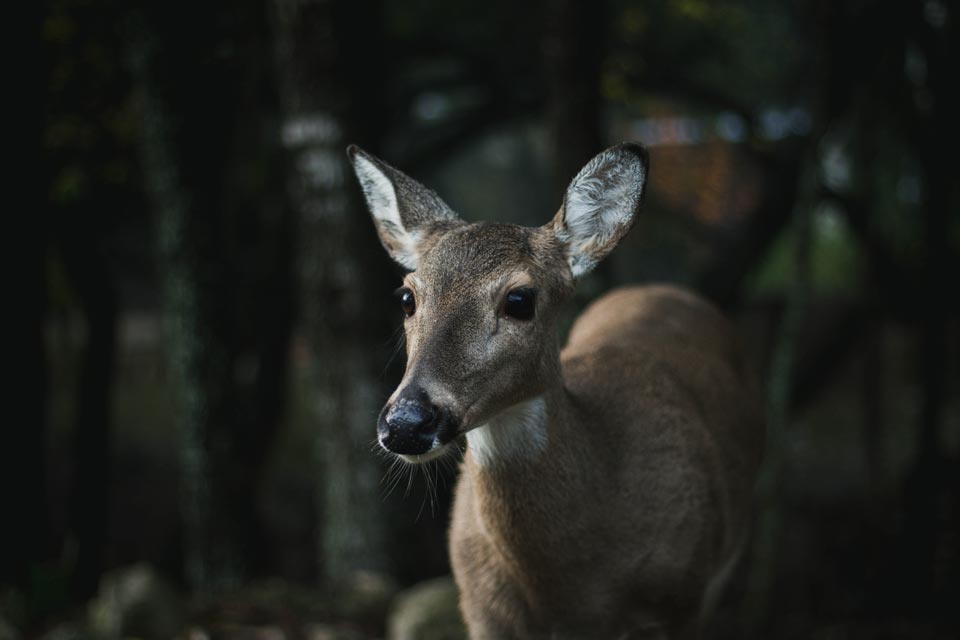On March 29, 2013 we captured an adult buck (he had his first set of antlers in autumn 2012) on the Bald Eagle State Forest. We slapped a GPS collar and some ear tags on him and number 8917 was born. We followed him through 2 hunting seasons. So how did he do it?
The map below shows all 2,570 locations we collected on him during 2013. Every 7 hours from 3/29/2013 through 9/30/2013, every 3 hours from 10/1/2013 through 11/16/2013, and every 20 minutes during the rifle season (11/25/2013-12/8/2015).
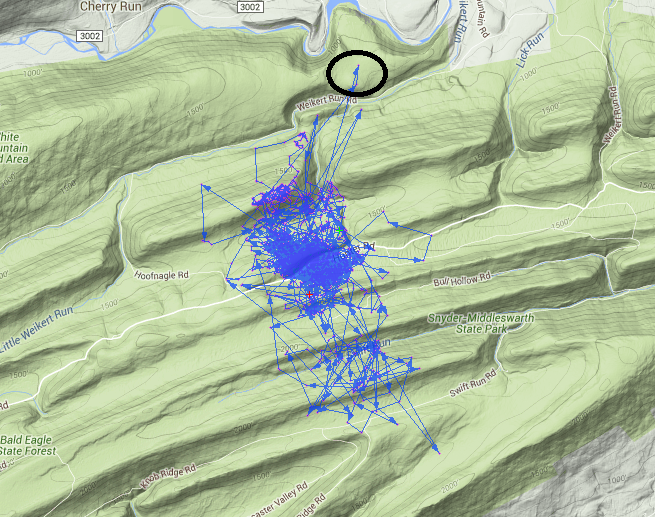
The general pattern you see here is typical of bucks. There is a concentration of points (that solid blue mass in the center) where he spends most of his time throughout the year. However, you can see lots of outlier movements that, as you probably guessed, occurred during the rut.
However, I put a black circle around a location he visited to the north. This was not a rut movement. It occurred in June. But we’ll come back to that later.
You will also notice that his home range encompasses both sides of a road. Granted this is only a gravel state forest road, but it is always risky for a deer to establish a home range like this. The very first deer we captured on this study did the same thing and she ended up being killed in a vehicle collision. Apparently, you need to look both ways no matter the class of road.
So let’s see how this buck moved during March-June 2013. Pay careful attention to what happens on June 4th.
Pretty boring – basically he just bops around that core home range of under 1 square mile. Except did you catch that movement on June 4th? Here’s what he did:
In seven hours he managed to travel well over a mile from the core of his home range to a hillside to the north. Stayed there for less than half a day then returned to a ridgetop just north of his core home range by 7pm. That 1-mile excursion was a once and done thing. He never returned to that spot the rest of the year! Who knows why. But it gets even stranger. Keep reading.
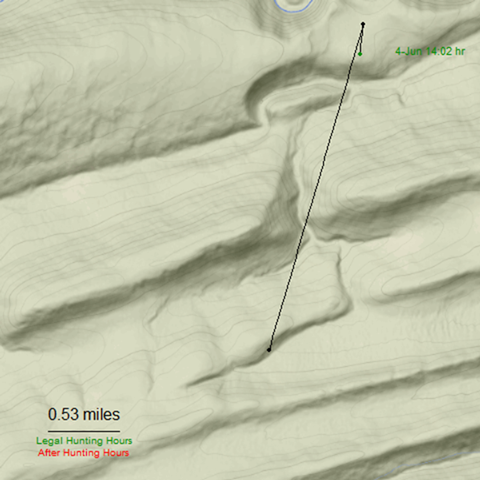
That ridgetop respite in his home range where he landed after his foray into the unknown is an important location in the life of this deer. We’ll “revisit” it in November.
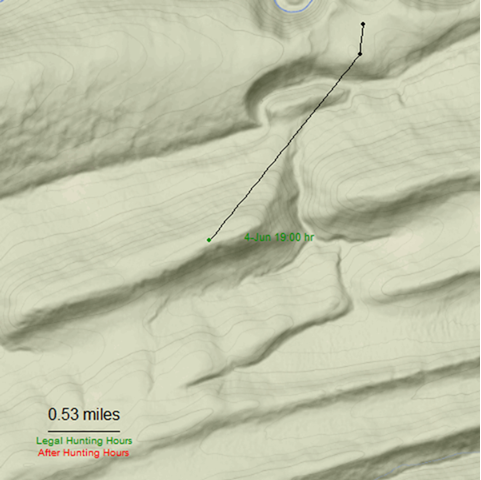
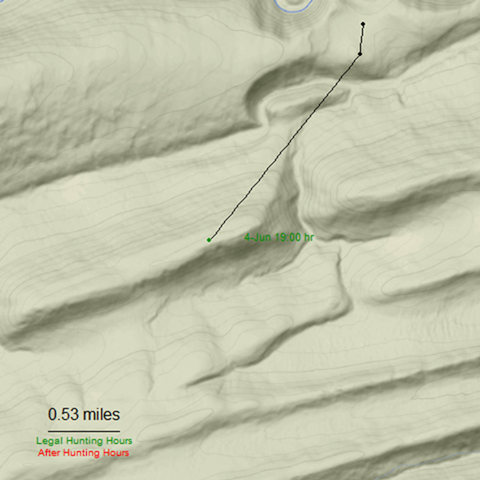

Next you can watch a video of his movements during July-September 2013.
Again, not very interesting. Most of his time is spent in an area of less than 1 square mile.
But now it’s October! For people, it is the season of everything pumpkin. For deer, it marks the beginning of the season of love. In a previous post we showed that on a population level the rut does not change from year to year. And the moon has no effect on the timing.
But every deer is an individual deer. The timing of the rut varies and could start in late October or be delayed until mid-November depending on the deer. Watch 8917 during October and November and see if you can tell on what date the rut started for him!
The rut results in an incredible amount of energy expenditure for bucks. While females are putting on weight, the bucks are losing it – just before winter. As you watched the video of his movements, notice they are nonstop.
As an example, lets take a look at a single 12-hour period. The 3 locations below represent a distance of 2.7 miles covered in 6 hours. In addition, this deer crossed 4 ridges for a total of 3200 feet in elevation change.
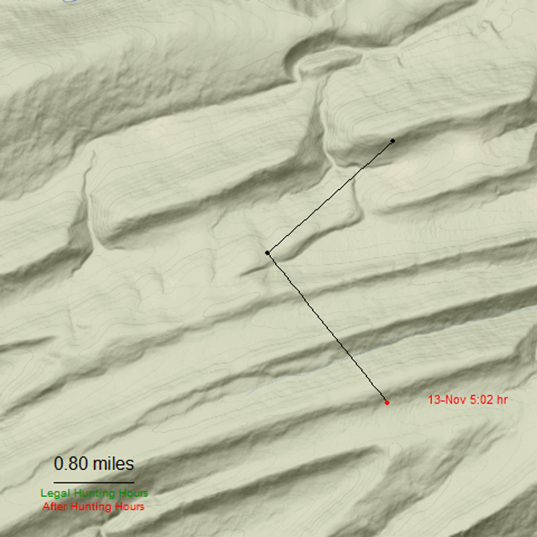
And he turned right around and ended up where he started 6 hours later! Another 2.5 miles in 6 hours and 2600 feet in elevation change.
During a 12-hr period he traveled over 5 miles and over a mile in elevation!
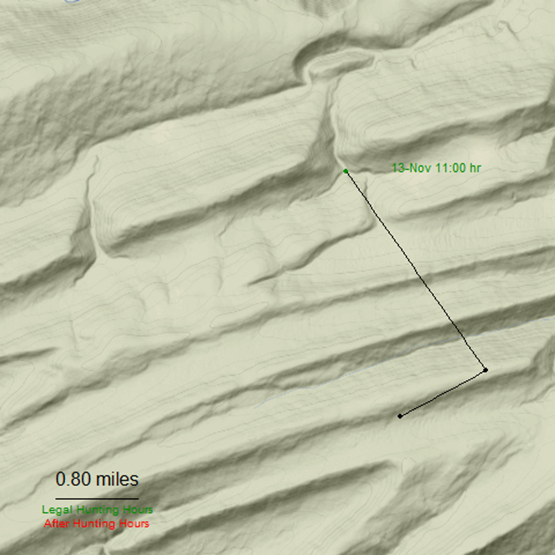
All told, between the 4th and 27th of November (24 days) he traveled 85 miles. The previous 24 days he traveled a total of 23 miles.
By the time Thanksgiving arrives, most adult females have been bred. Most remaining rut activity is related to fawn (6-month-old) females that have reached sufficient size to breed. However, Thanksgiving is also bear season and heralds the rifle season.
You’ve seen the video of this deer previously, but here it is again for your viewing pleasure. As we have shown from multiple deer (male and female), deer that survive the rifle season have a special hiding place. Usually on the top of a ridge where the prevailing wind from the west will let them know danger approaches, and where they can quickly jump off the side of the ridge and escape.
Buck 8917’s hiding place is that ridge respite on the north side of this home range.
So Buck 8917 survived his 3rd hunting season. What does 2014 have in store for him? Let’s start with another image of his travels over the complete year.
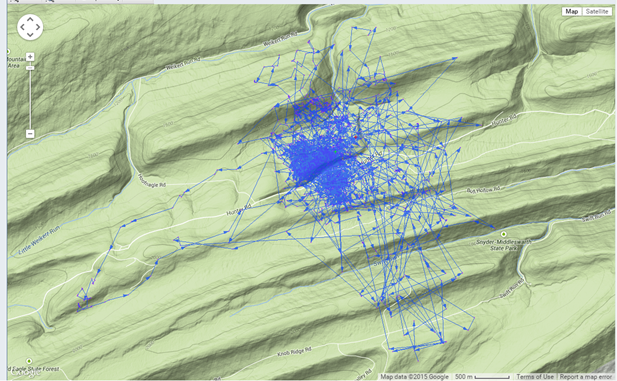
Looks like 2014 isn’t very different. But there are a few points to note:
- That far northern ridge outside of his home range that he visited once in June 2013 is never visited in 2014.
- The core home range does not change
- He does not appear to have a cluster of locations on the ridge where he hid during rifle season in 2013, but there are a cluster of points lower down on the ridge. Were there hunters up on top in 2014?!
- His rut movements are similar to 2013. But that long-range move out and back to the west? That may not have been the rut as it was the first Monday of bear season!
Let’s see what he does January-March 2014
And here’s April-June 2014
And now July-September 2014
And now the 2014 rut! During this year’s rut he traveled 92 miles in 24 days!
And again during the rifle season you can see how he reacts. Both male and female deer reduce their home range to about 100 acres during the daytime hours of the rifle season. That’s a far cry from ~3 square miles during the rut!
So now you have been able to follow this deer for 2 years. What happens in 2015? Watch the movie below.
Why does the video end in January? And did you notice he returned to the spot he hasn’t visited since June of 2013?
It turns out that Buck 8917 died in January of 2015. From what we could determine it was not a quick death because we received a signal that he had not moved for >8 hours, suggesting he may have died. But the next day he moved a couple of hundred meters. Finally, it was clear based on the temperature of the collar and the lack of movement that the deer had died.
Unfortunately, a major snowstorm arrived that prevented the field techs from reaching the carcass for over 24 hours and in that time the coyotes found the carcass first. It was clear the coyotes did not kill the deer because the carcass was covered in snow prior to being scavenged.
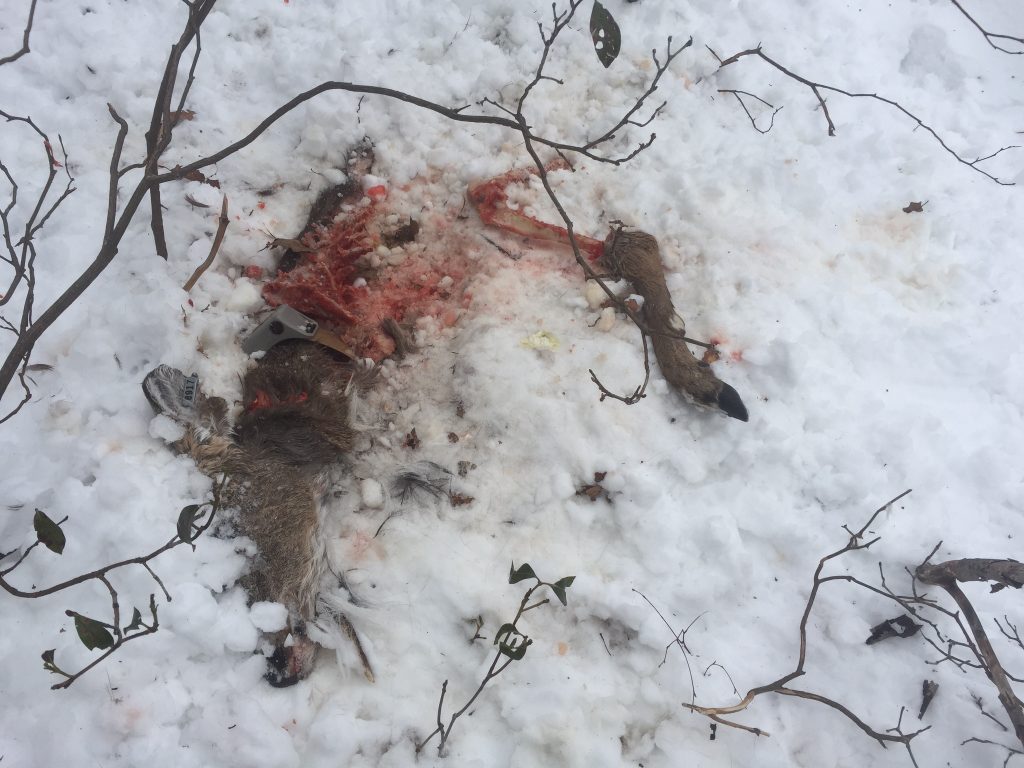
We will never know why this deer picked the spot it did to die. What is fascinating (weird/creepy/surreal) is that Buck 8917 visited this spot well outside its home range only one other time in the 2 years we monitored him. Why go there to die?
-Duane Diefenbach
If you would like to receive email alerts of new blog posts, subscribe here.
And Follow us on Twitter @WTDresearch
